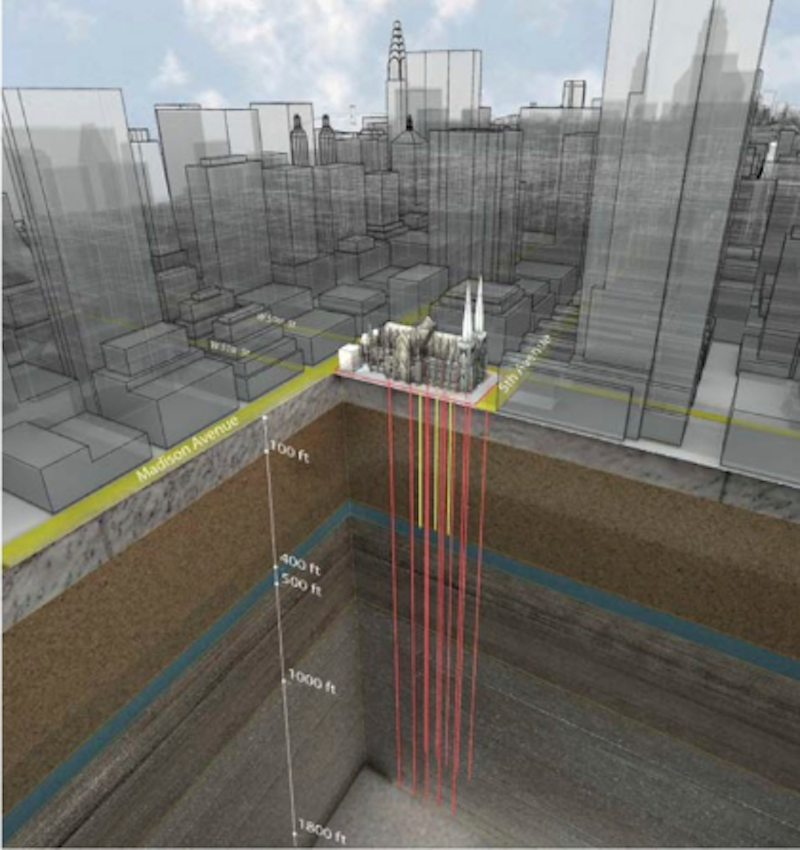As part of the effort to adapt St Patrick’s Cathedral in New York to the structural and environmental standards required of the 21st century, the building has been integrated with a state-of-the-art geothermal plant. The new plant allows the cathedral and adjoining buildings to regulate temperature with increased efficiency and a reduction in CO2 emissions.
In order to accomplish this task, the project’s design team - featuring Murphy, Burnham, & Buttrick, Landmark Facilities Group, and PW Grosser - repurposed the existing infrastructure to harness clean, renewable power from an underground system of 10 wells. Four wells on 51st Street and six wells on 50th Street were drilled to a depth of up to 2,200 feet.
A Dedicated Heat Recovery Chiller extracts thermal energy from the wells and distributes it throughout the campus for heating and cooling purposes. Working in conjunction with the Dedicated Heat Recovery Chiller to accomplish this task is a column hybrid open loop system made up of heat exchangers, air handlers, and fan coils. This system extracts and redirects heat throughout the 76,000-sf building.
St Patrick’s Cathedral’s geothermal plant differs from most in that it is designed to automatically split its cooling and warming functions in order to simultaneously heat or cool the varied areas it services. Most geothermal plants alternate between their warming and chilling functions. The Cathedral’s new plant is capable of generating 2.9 million BTU’s per hour of air conditioning and 3.2 million BTU’s per hour of heating when fully activated.
An additional challenge faced when installing the system was maintaining the standards set for the historic preservation of one of New York’s oldest landmarks. “At the outset, we evaluated a conventional HVAC system, but determined it would pose too many challenges for this historic building,” says Richard A. Sileo, Senior Engineer with Landmark Facilities Group, in a release. “We conducted a feasibility study and found that a geothermal system let us meet our goals with the smallest impact.”
Initial drilling of the wells began in June 2015 and the plant was finalized and ready to launch by February 2017.
Related Stories
| Jan 19, 2015
Gaudi’s first work outside Spain will be a chapel in Chile
Nearly 100 years after Antoni Gaudí’s death, Chile will begin constructing a chapel using his designs.
| Jan 9, 2015
Santiago Calatrava talks with BBC about St. Nicholas Church on Ground Zero
Calatrava reveals that he wanted to retain the “tiny home” feel of the original church building that was destroyed with the twin towers on 9/11.
| Jan 2, 2015
Construction put in place enjoyed healthy gains in 2014
Construction consultant FMI foresees—with some caveats—continuing growth in the office, lodging, and manufacturing sectors. But funding uncertainties raise red flags in education and healthcare.
| Dec 28, 2014
AIA course: Enhancing interior comfort while improving overall building efficacy
Providing more comfortable conditions to building occupants has become a top priority in today’s interior designs. This course is worth 1.0 AIA LU/HSW.
| Dec 2, 2014
Nonresidential construction spending rebounds in October
This month's increase in nonresidential construction spending is far more consistent with the anecdotal information floating around the industry, says ABC's Chief Economist Anirban Basu.
| Oct 23, 2014
Santiago Calatrava-designed church breaks ground in Lower Manhattan
Saturday marked the public "ground blessing" ceremony for the Saint Nicholas National Shrine, the Greek Orthodox Church destroyed on 9/11 by the collapse of the World Trade Center towers.
| Oct 16, 2014
Perkins+Will white paper examines alternatives to flame retardant building materials
The white paper includes a list of 193 flame retardants, including 29 discovered in building and household products, 50 found in the indoor environment, and 33 in human blood, milk, and tissues.
| Oct 15, 2014
Harvard launches ‘design-centric’ center for green buildings and cities
The impetus behind Harvard's Center for Green Buildings and Cities is what the design school’s dean, Mohsen Mostafavi, describes as a “rapidly urbanizing global economy,” in which cities are building new structures “on a massive scale.”
| Oct 14, 2014
Proven 6-step approach to treating historic windows
This course provides step-by-step prescriptive advice to architects, engineers, and contractors on when it makes sense to repair or rehabilitate existing windows, and when they should advise their building owner clients to consider replacement.
| Oct 12, 2014
AIA 2030 commitment: Five years on, are we any closer to net-zero?
This year marks the fifth anniversary of the American Institute of Architects’ effort to have architecture firms voluntarily pledge net-zero energy design for all their buildings by 2030.
















